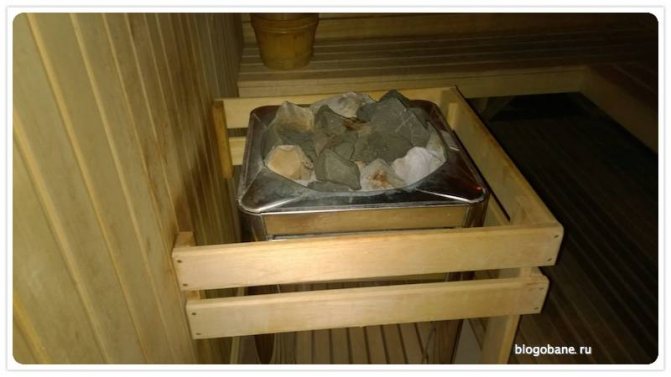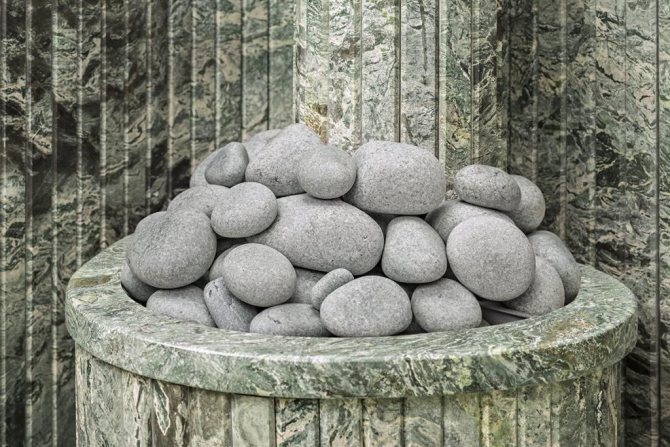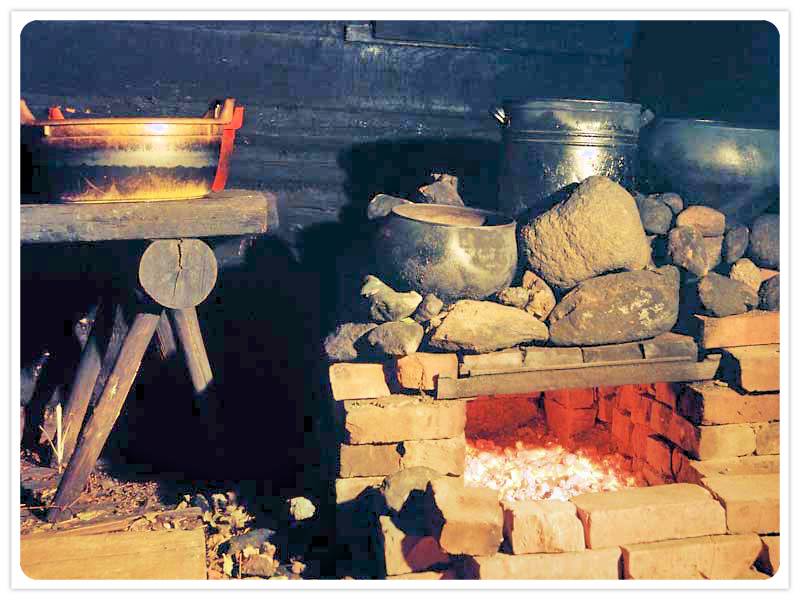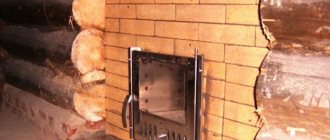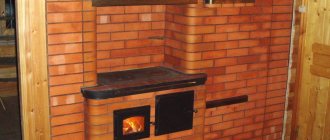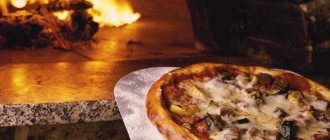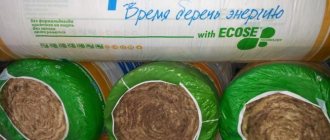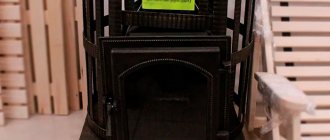How to properly place stones in the sauna stove
What function does a stone perform in a bath? Most see him steam generator, and already in the second place heat accumulator... But these are things that are directly related to each other: vaporization occurs at a certain temperature, to which it must still have time to reach before starting the procedures.
It is logical to assume that the heating rate of the stone will depend on the way it is placed in the sauna oven, but the design of the furnace itself plays a role here. there is convection ovens - they were purposefully created in order to reduce the amount of fuel and the time for heating the premises. As a result, we get a short heating, after which the bath is ready, but the stones are not yet. No matter how you put them, they simply do not have time to heat up in a short time, so they will give weak steam. That's why economical convection ovens are much more often used in saunas, rather than Russian baths.
If you heat an ordinary, for example, a brick stove for a long time, then everything will heat up evenly - both the air and the stove. In this case, the return will also be long, because the heater starts "working" after the stove is no longer heated. Our task is to use some tricks in order to achieve the shortest time to bring the stove to the desired state.
The stone has two important characteristics: heat capacity and thermal conductivity... And if we want to at least slightly accelerate their heating, then closer to the fire, it is better to put those with a higher thermal conductivity and a lower heat capacity. So the heat will be transferred faster to those that lie higher, up to the very top. See the heat capacity table and other details in the article What stones for a bath to choose.
This condition is easy to fulfill if use layers of different rocks. Because there is another rule that practically cancels the first one:
Judge for yourself: the larger the stone, the more heat is needed to heat it up. However, the smallest ones are also not easy to heat - they have a smaller contact surface required for heat transfer. All this can only be solved by choosing the correct size of fractions, which will be discussed below.
So, you have selected the largest copies in the batch and are going to put them on the bottom. How to do it correctly, given that their shape is arbitrary, often extended to one side.
This rule is empirical, but it may also be due to the higher rate of propagation of thermal energy along the layers, and not across them. Another reason for this choice is the need for free passage of hot air between the stones. End masonry increases the amount of gaps between stones.
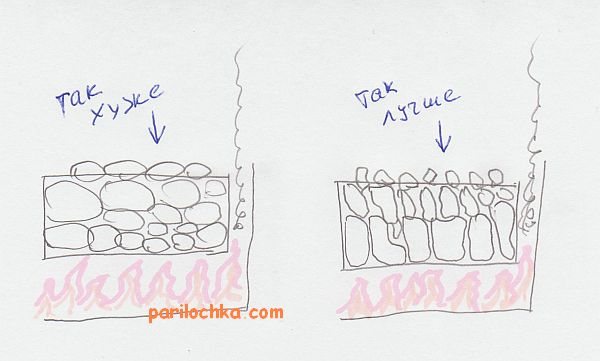
After laying the first row, lay the next fraction as the next row. Laying tightly is still not worth it. After all, in addition to the fact that we must ensure air circulation, we also need to leave a little space for the future. thermal expansion of stones. It is, of course, different for different breeds, but it happens in all cases. The stone increases in size, and dense packing leads to the emergence of compressive forces that destroy the stone.
Professional advice
Avid bathers know a lot about the bath process. They use a variety of brooms, experiment with steam, practice several long runs. As for the selection of stones, here, too, professional bath attendants have their own tricks:
- Disinfection of stones can be carried out with an ordinary strong salt solution in proportions of 1: 3.Minerals are soaked in a bucket for a day, after which they are washed and placed in an oven.
- To speed up the heating process and retain heat, stones are mixed with cast iron blanks. Even the next morning in such a bath, you can wash with comfort.
- To saturate the steam with healing components, it is better to use herbal decoctions, rather than oils and aromatic balms. They are able to leave carbon deposits on stones that are difficult to clean. Oils and balms can be used as fragrances in the form of open vessels placed on the shelves of the steam room.
- You need to splash water on the stove without fanaticism. It is enough to water the stones with a special device. Steam from such an amount of water is no less, and the benefits for preserving stones in proper form are more. In addition, a metal sauna stove is used for a longer time without stress for the material of the body and grate.
Compliance with all the rules and tips will help a beginner in the bathing business to fall in love with the process of the most affordable way of healing in Russian.
A private bath is not only a pleasant pastime with friends and relatives. This is responsibility for your own health. The choice of stones for the stove is an important point in the complex of measures for the preparation of the steam room. Follow the points in this article to ensure that your bath procedures become regular, useful and enjoyable.
Is it possible to mix stones for a bath
The answer to this question is definitely yes. You can mix. Moreover, you are free to lay them out in layers or mix different ones within one layer.
Many of those who have an open fire in the stove or have no opportunity to fill the entire volume with expensive rocks use cheaper for lower layers... Or they do the same for other reasons, for example, as mentioned at the beginning, so that accelerate heating due to different thermal conductivity and heat capacity of rocks. The third reason is purely aesthetic... You can choose the colors so that they look beautiful when wet. For example, mixing green and red specimens. Or red and gray.
Which shape is the best?
We have already considered this issue in the article on the choice of stones. Recall that the choice most often lies between stabbed and tumbling varieties. Sanded are less common and we will not advise taking them, because they do not hold water at all on their surface. The stone must be at least slightly rough.


As for the advantages of the chipped version, they are all enclosed in a larger surface area of the uneven stone. It has much more disadvantages - where it is thin, there it will break off, chipped samples often have cracks (when tumbled, the most durable remain), in general, the tumbling option is better, and its only drawback is the higher price.
Features of talcomagnesite
Warm stone has several advantages over other materials:
- Talcomagnesite, even at temperatures over 1500 degrees, retains its strength and environmental friendliness. When exposed to the highest temperatures, no harmful substances are released, they simply are not in its composition. The heat of such a furnace always lasts longer, yes, talcomagnesite furnaces heat up longer than, for example, metal furnaces, but they also retain heat for a long time. This feature has been confirmed experimentally, even when a warm stone is lowered into water, it retains its heat for about an hour.
- Magnesite makes a warm stone one of the most durable natural materials. the pattern after veneering is very similar to marble works, which makes it an elite and elegant material. Talcomagnesite is waterproof, this feature makes it possible to use it for finishing saunas and swimming pools. If talcomagnesite gets wet, it does not slip, which makes it the most suitable material for the construction of water structures.
It has been proven that talcomagnesite is not only an environmentally friendly material, it also has a number of healing properties, has a positive effect on the human body, the heat radiated from a warm stone perfectly relaxes and soothes.
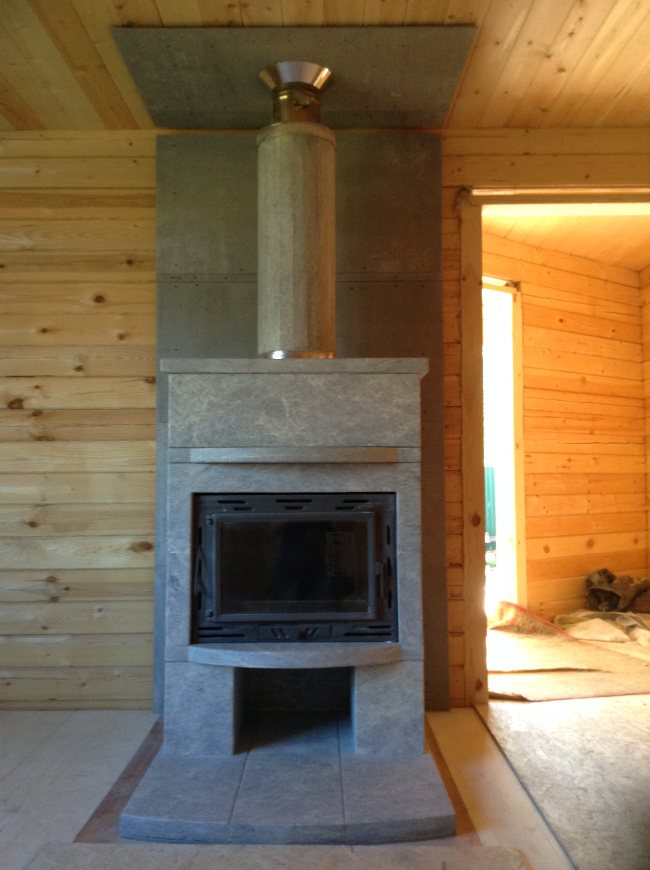

Products made of warm stone will last for more than a decade, this material is strong and durable, not even afraid of temperature changes, which allows it to withstand the most severe climate.
Warm stone has no drawbacks, the main thing when choosing a material or product is not to buy a fake, there must be documents confirming the quality.
How to prepare a stone?
Preparation includes testing. You need to do the following:
- just soak the batch in water without anything for several hours (you can skip this, but this is also a test: watch out for gas bubbles - this is a sign of cracks, specimens with bubbles must be removed);
- then go over each well with a stiff brush and rinse under running water.
The washed batch can be ignited and thrown into water. If any of them break, they will be rejected.
In the future, the stones will need to be sorted out with a certain regularity. You can do this once a year, every six months, every season. Deterioration in the quality of heating can be a signal for an unscheduled revision.
How much stone should be used?
There can be no definite answer here, because the breeds are different. However, no breed will last forever. With time stones are coked, covered with carbon deposits, some of them change their structure, become porous, crumble into dust, others burst into pieces. Only a check can show how many of them are out of order and need to be replaced.
The "dead" stone ceases to keep warm at all. It is easy to define him - it seems that he crusted... If the steam room starts to cool down quickly, check the heater, it may be time for a replacement.
Another thing that affects the service life: the temperature of the water that you supply for steam - it is better that it was hot, as well as contact of stones with an open fire - when he is not, they last longer.
*** So, to summarize what has been said: to put stones in the sauna stove correctly is to put them in descending order from the largest (10-12 cm) to the smallest (5-6 cm), and the lower layer must necessarily "breathe", that is, there you need to leave a little more free space between the stones.
We are confident that you will succeed with our recommendations. Light steam!
General recommendations for the selection and placement of stove stones in the heaters of baths and saunas
Properties of stones:
General recommendations for the selection and placement of stove stones in the heaters of baths and saunas
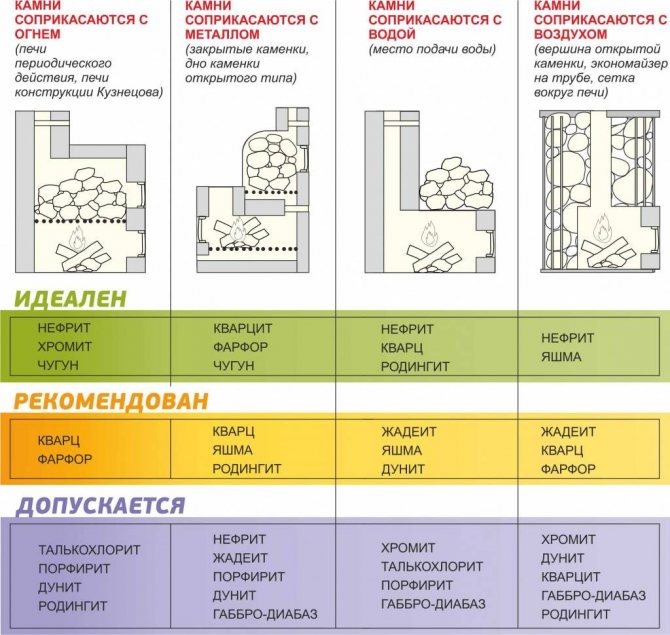

The stones placed in the heaters of baths and saunas must meet a number of general requirements:
1.For better adhesion (adhesion of water and stone surface), it is recommended to use chipped or bonded stones. Water from polished or polished stones will drain onto the metal, from where it will subsequently evaporate.
2. Absence of cracks. The stones should not have visible cracks and have a homogeneous structure, excluding their occurrence in the future.
3. Absence in the composition of carbonates. Bright signs of carbonates are white spots or cleavage chips that are easily scratched with a steel needle.
4. Absence in the composition of asbestos. Vivid signs of the presence of chrysotile asbestos (a mineral with fibrogenic properties) in the composition are the villi visible to the eye on the surface of the stone.
5.Lack of dust. The stones must be clean. To do this, immediately before laying, they must be thoroughly rinsed (this must be done, even if the stones are visually clean).
In addition to the above requirements, there are also a number of highly specialized ones, depending on where the stones are used.
1. For intermittent furnaces, when the stone fill comes into contact with fire, it is important to select stones with the highest possible melting point.
2. For places where stones come into contact with metal (for example, the bottom of an open-type heater), a high thermal conductivity is important.
3.In the places where water is supplied, it is necessary to choose stones that are resistant to sudden changes in temperature and have pronounced lithotherapeutic properties.
4.If stones are used as backfill in an economizer or a grid around the stove, it is preferable to use a backfill with high decorative qualities, as well as having lithotherapeutic properties.
5. Attention! When placing stones in electric heaters, it is prohibited to use chromite, jasper.
What else should you pay attention to?
It is important to be confident in every stone that you use as a stove backfill and to give steam without thinking about possible troubles.
On the conscience of the manufacturer are indicators such as environmental friendliness, radiation safety, the absence of minerals in the stone that are harmful to health.
So that these invisible enemies of man do not spoil your pleasure from the bath, ask the sellers for a certificate of conformity and an expert opinion for a sanitary and epidemiological examination of stones. Remember, the stones must be certified SPECIALLY for use in bath and sauna heaters.
It is better if the stones that you buy will have a recognizable trademark from an understandable, real manufacturer.
Useful properties of peridotite
All the steam rooms of the bath complex with apartments in Aprelevka use the mineral stone peridot. Read about the useful and healing properties of the steam from these stones in detail at this link, and we wish you a light steam!
Steam room
To rent a bathhouse in the Moscow region or a sauna in a country cottage, call right now
